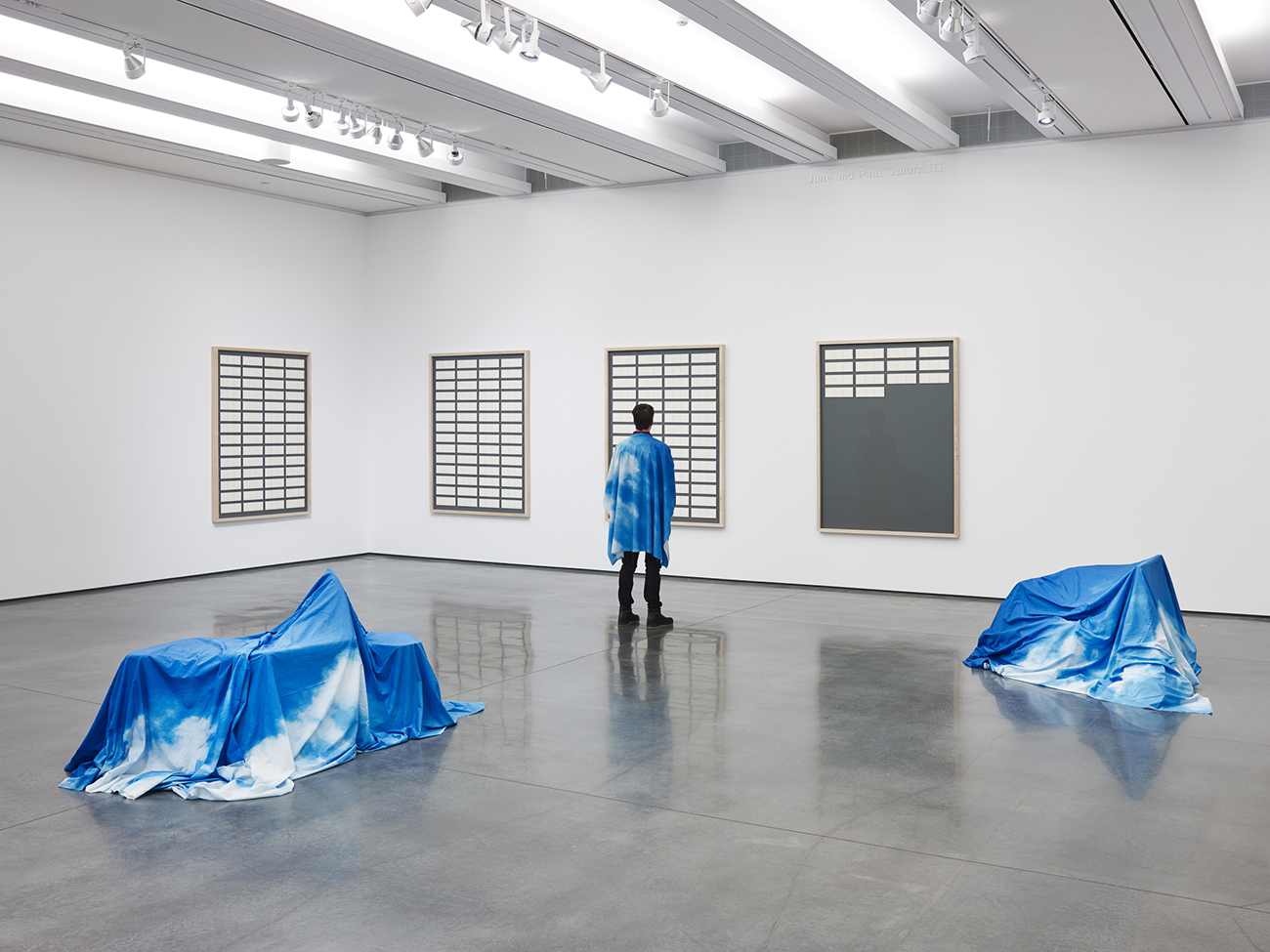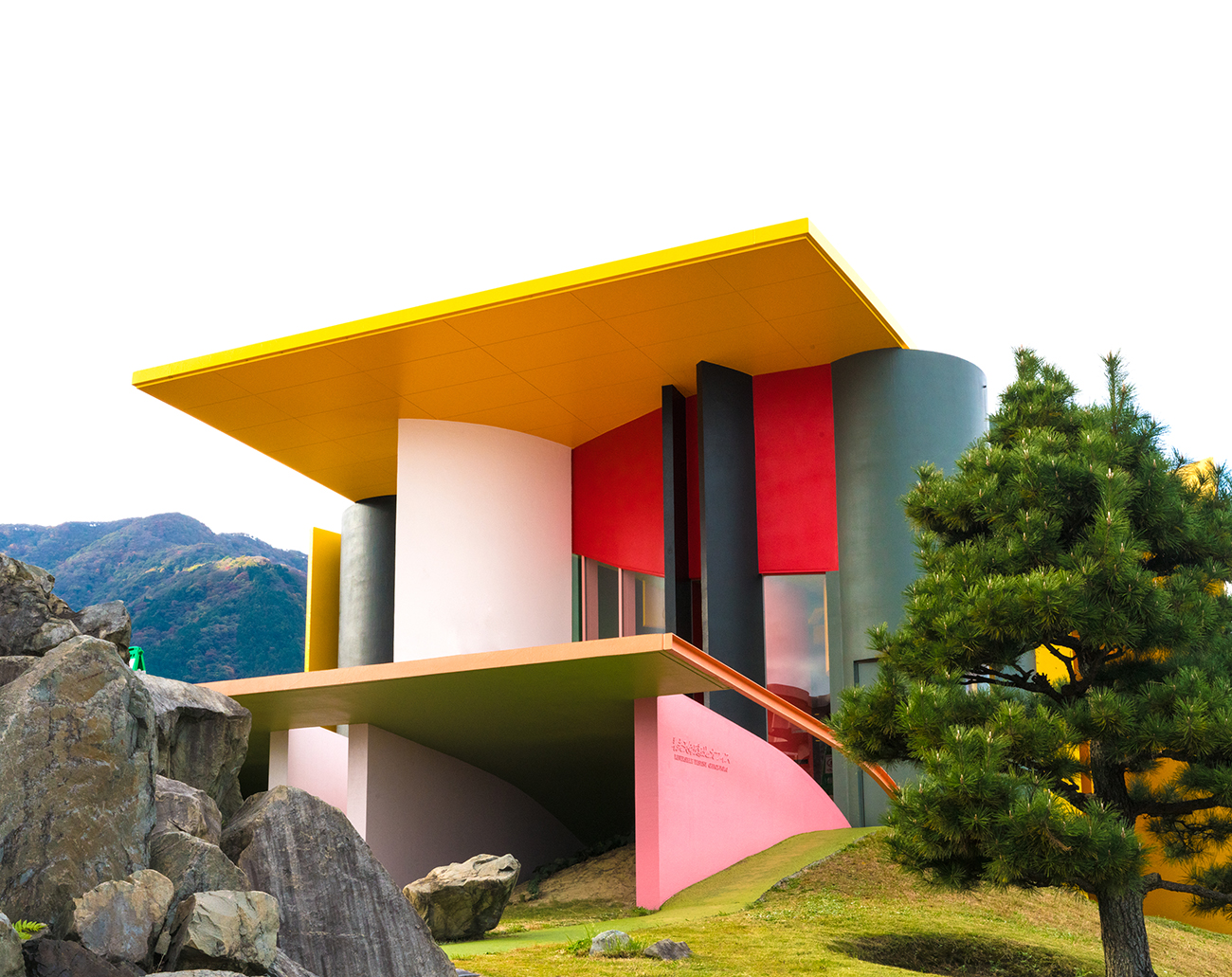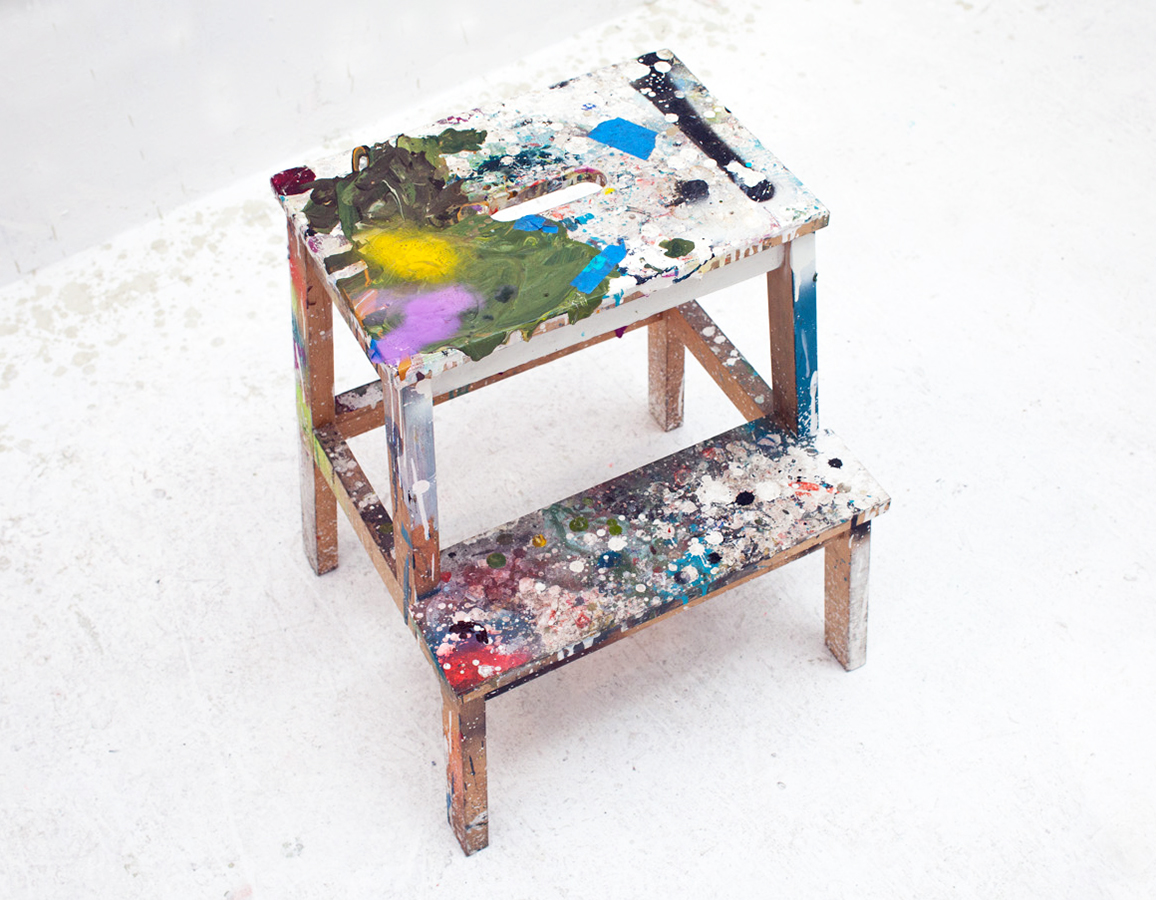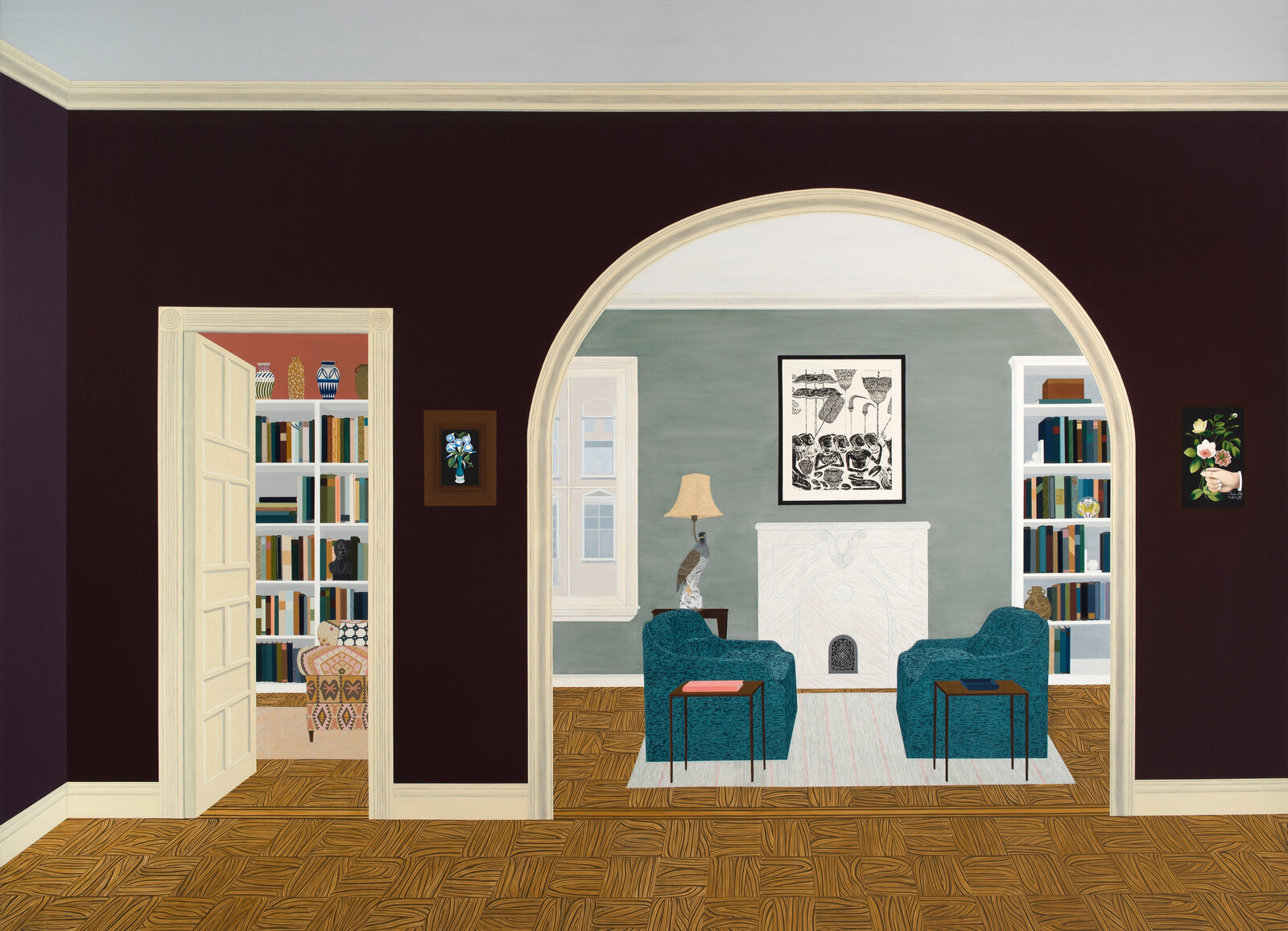
05.18.21
Q+A
In Her Paintings, Becky Suss Creates Real or Imagined Interiors From Memory
Because we don’t cover art as our primary discipline here at Sight Unseen, we typically discover artists at a more glacial pace than we do designers — usually by way of gallery shows, art fairs, or Instagram wormholes. But I discovered Philadelphia-born painter Becky Suss in perhaps the most Sight Unseen — or at least the most me — way possible: Her 2016 painting, August (above), adorns the cover of LA harpist Mary Lattimore’s Hundreds of Days, one of the many albums that helped propel me through the emotional black hole of 2020. When I probed a bit deeper, I found that Suss’ paintings have in fact been featured on all of Lattimore’s solo albums since 2014. But this one felt the most resonant, probably because its subject is my main professional preoccupation — a home. Not just any home, but a cozy, well-appointed home, with enough room for matching sofas, enough bold taste to include a bird-shaped lamp, and enough curiosity and intellectualism to house shelves upon shelves of books. In other words, the kind of home many of us wish we could have quarantined in last year.
And that’s perhaps the beauty of Suss’ work. Most of her paintings are her own interpretations of real, fictional, or imagined interiors, and they’re often concerned with ideas about memory and its quicksilver ability to reinforce or betray our sense of place. Many of her subjects are personal — the now-demolished site of her grandparents’ Long Island home, for example — but because their subject is interiors, with common or familiar flourishes, and decorative touches that we recognize from our own lives, they feel at once aspirational and universal. We recognize a part of ourselves in her paintings even as we wish we could be the kind of people who inhabit them. “Devoid of figures, Suss’ style uses flattened architecture, exaggerated proportions, and distorted perspective to amplify the tension between the factual and the fictitious, mirroring the plasticity of memory, continually reformed and revised. What resonates is how a dwelling, despite its rigid physical structure, can adapt, welcoming the day-to-day histories, eccentricities, and impressions of the people who move between its walls.”
Her work is currently included in a group show at The School by Jack Shainman Gallery in upstate New York; curated by Helen Molesworth, the show is centered around the idea of feedback. “Some of the artists are interested in the twisted history of America. Others are interested in the persistence of quotidian pleasures as best exemplified by still life or contemporary tableaux of everyday life. Some artists have combined their sense of America’s untold narratives with the gentle ebb and flow of daily life.” Suss’ work combines all of these themes, exploring everything from the racial history of America as referenced in children’s literature to the ignored legacies of female homemakers to the daily pleasures of life and learning at home. We recently spoke to Suss via Zoom about all of these and more.
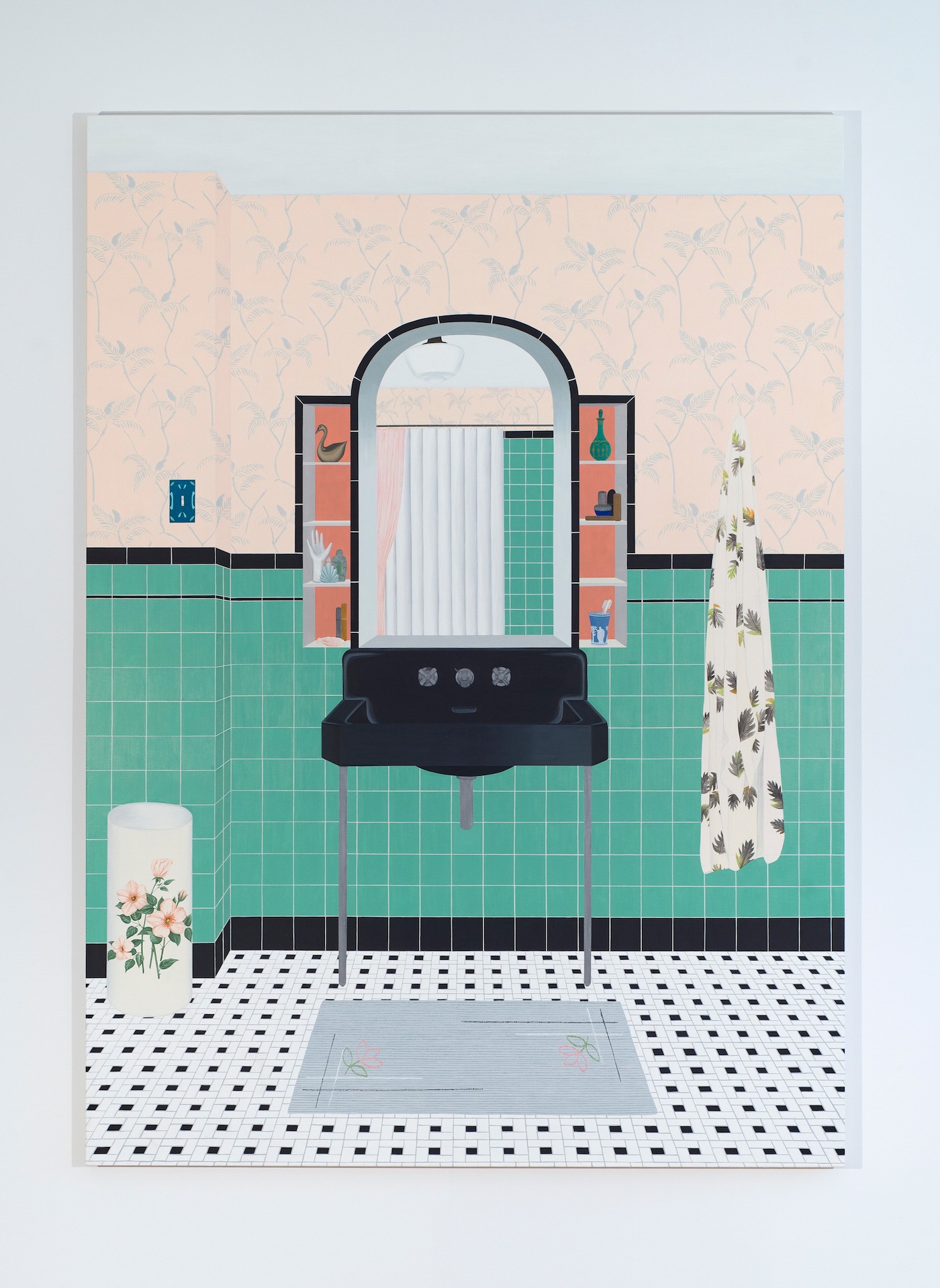
Bathroom (Ming Green), 2016
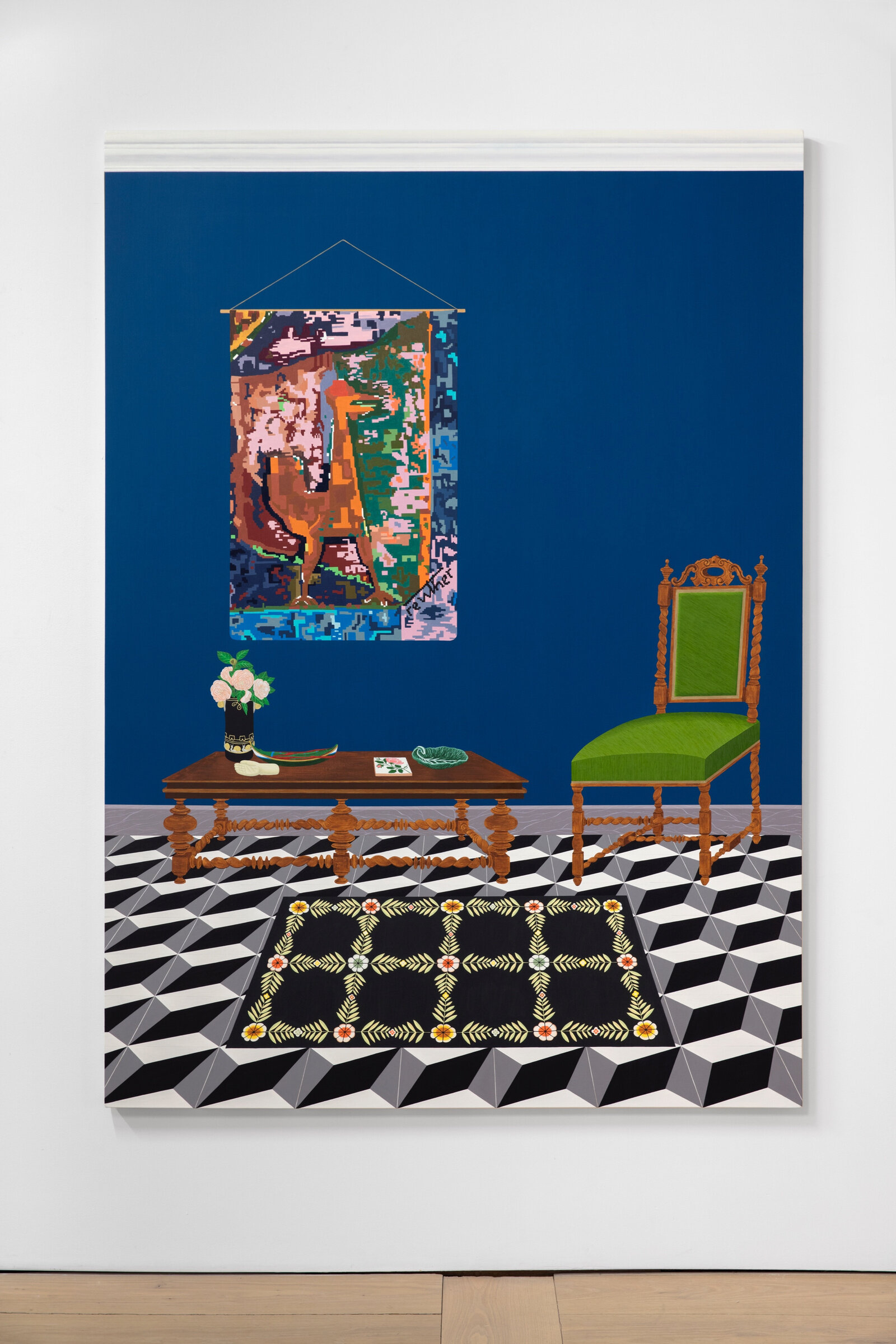
Untitled (Portugal), 2018
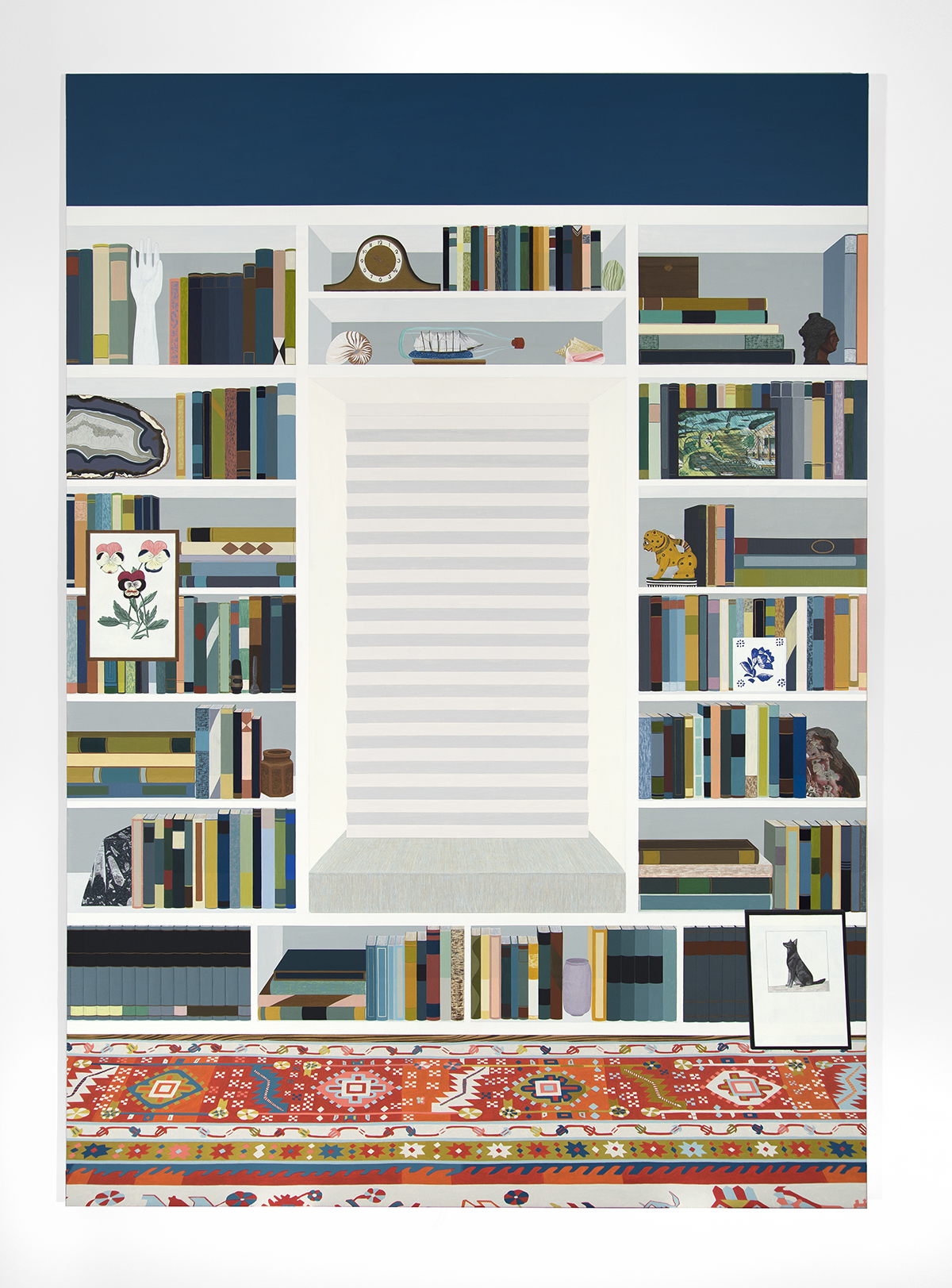
Home Office, 2016
Let’s start by talking a bit about your background. What inspired you to take up painting in the first place?
My mom taught art education — like, how to look at art for little kids, the basics of composition and color, all of those things — and she was always taking me to museums. My great uncle was a painter who lived here in Philadelphia — a WPA-era guy who made jewelry, had a little ad agency, made paintings and sculptures. We were really close. I would see him once or twice a week until he died at 100. He was a big influence.
There were always people in my life like that who valued art. And painting always made sense to me. It was intuitive, and I think that that’s the way a lot of my career and work has gone. I’ve done things that made sense to me, without over thinking the why of that too much, and it’s worked out.
How did you specifically get into painting interiors?
I worked in small-scale paintings and landscapes for a long time. Those paintings were small and impasto, and there was a lot of building up of the surface and scraping it down, thinking about the geology of the landscape and the geology of the painting. So, it was different from my current work in that respect, but there was always this underlying idea of thinking about remembered landscapes, a sense of place, and a sense of memory.
I grew up on the East Coast, but then I went to graduate school in Northern California. I wanted to go somewhere where the landscape was more interesting. While there, though, I got sort of homesick for the East Coast, and I started making bigger paintings with very specific remembered landscapes. For example, there’s a place in Dorset, Vermont, where there’s this beautiful quarry — one of the oldest white marble quarries in the country — and we would go swimming there when I went to school in Northern Massachusetts. So, I made a painting of this quarry, and I did the same with a couple of other very specific places like that.
Then, I moved back to Philadelphia. I was like, what am I doing? I’m here in this place, and I’m making work about missing it? So, I spent a few years doing other things, but then in 2011, my grandfather died. He and my grandmother had this house in Great Neck, Long Island, which they had built in 1955. They lived there their entire life until they both died. We inherited all of the small stuff — the lamps, the mugs, the light switch plate covers — but also the big things, like the furniture and the house itself, which sold to somebody who demolished it and built a little McMansion on the footprint.
It was weird because though house had totally disappeared, I was surrounded by all of this familiar stuff. That’s where the interior paintings first came from. I had these objects, and they weren’t just in my house. They were in the studio. They were everywhere.
So, I was like, you know what? I want to make a painting about this stuff. I picked a very specific spot in my grandparents’ house, where my grandfather would sit in his chair with all of his books around him, and I made this painting. It wasn’t streamlined the way my paintings are now; I think I painted it over a landscape that was unsuccessful. But I made it and was like, “Oh, this makes so much sense.” It combined a lot of the things I had thought about for a long time — a sense of home, a sense of memory. The interior provided so much specificity, but also so much relatability. It was universal and specific at the same time.
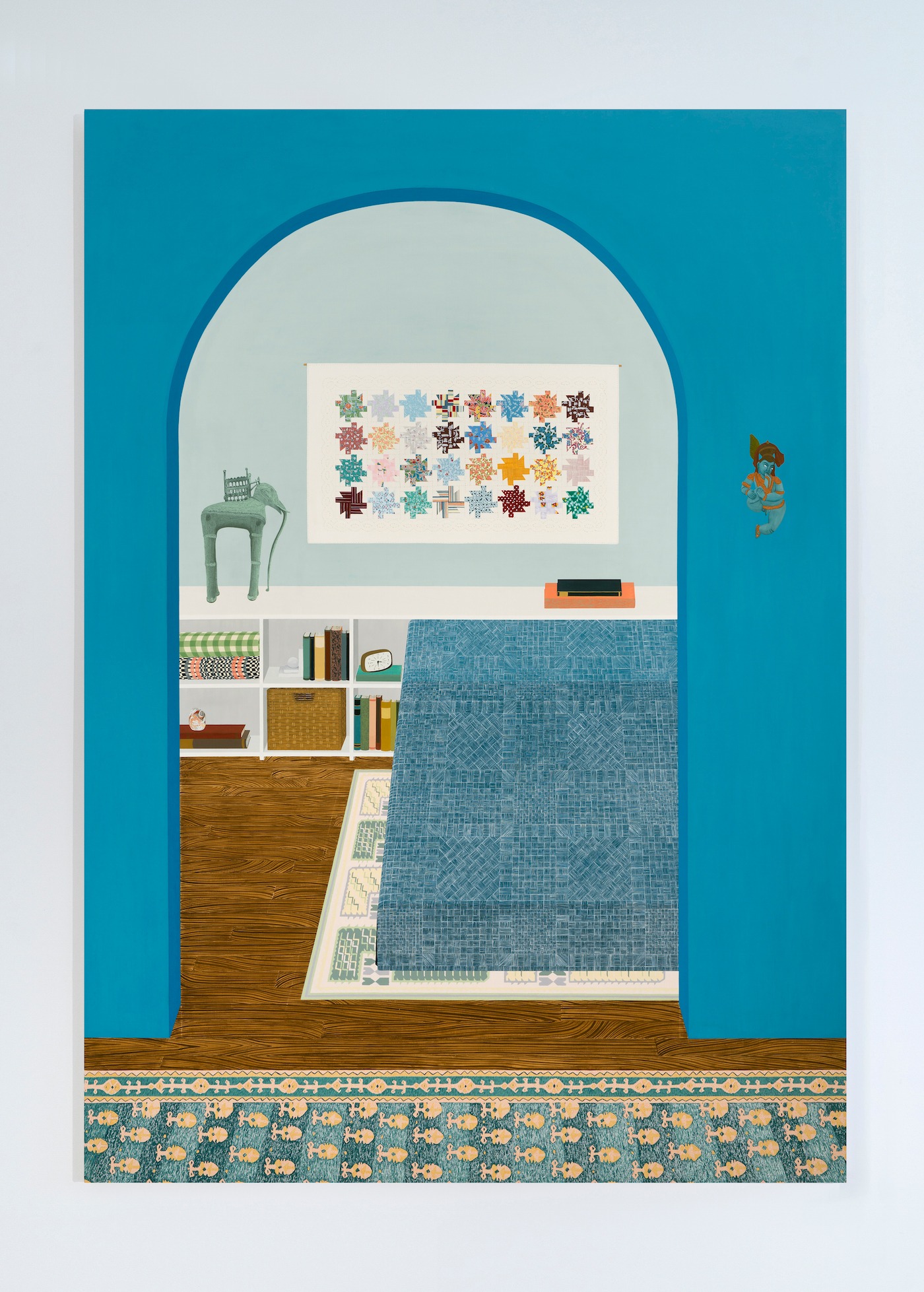
Blue Apartment, 2016
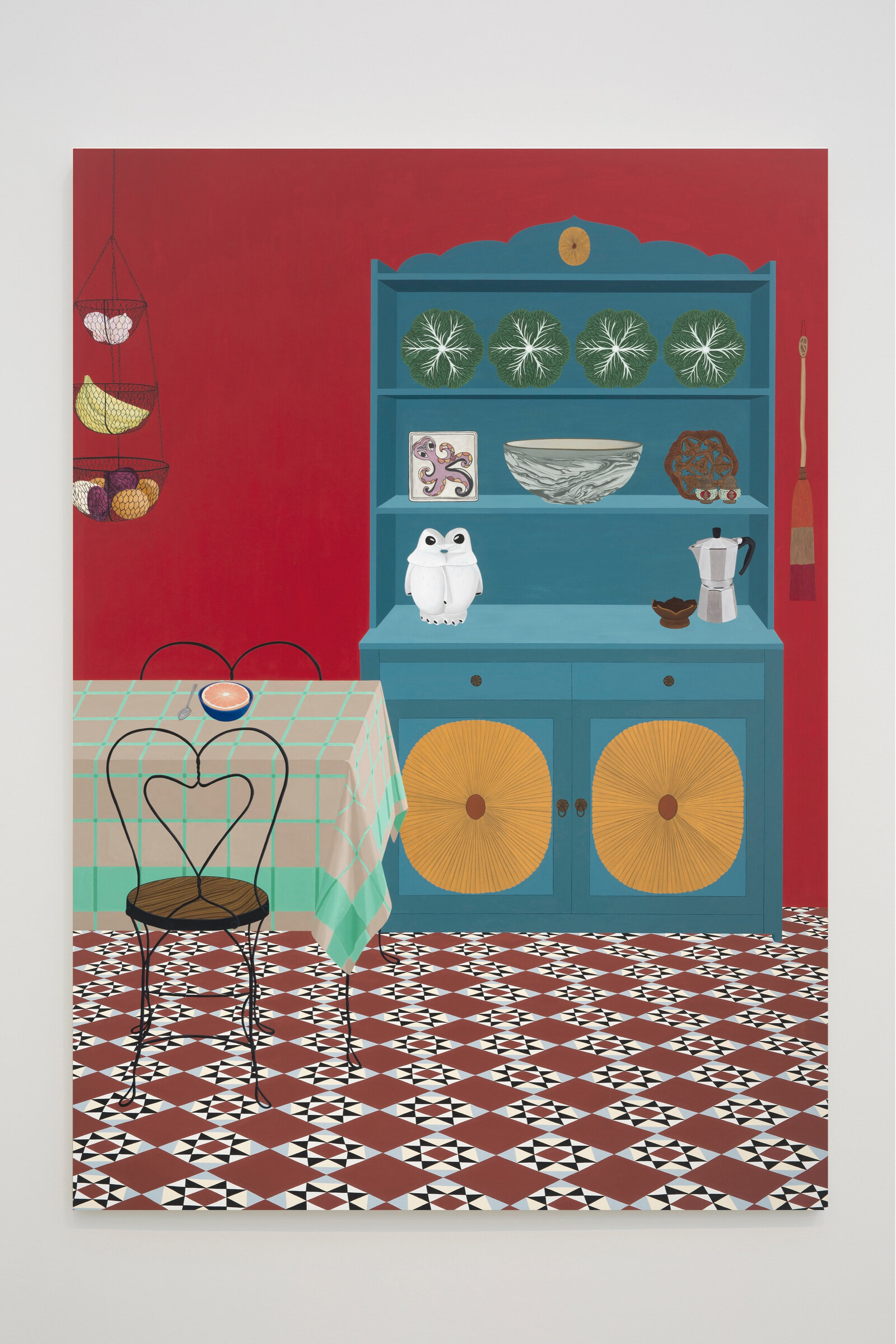
Red Apartment, 2016
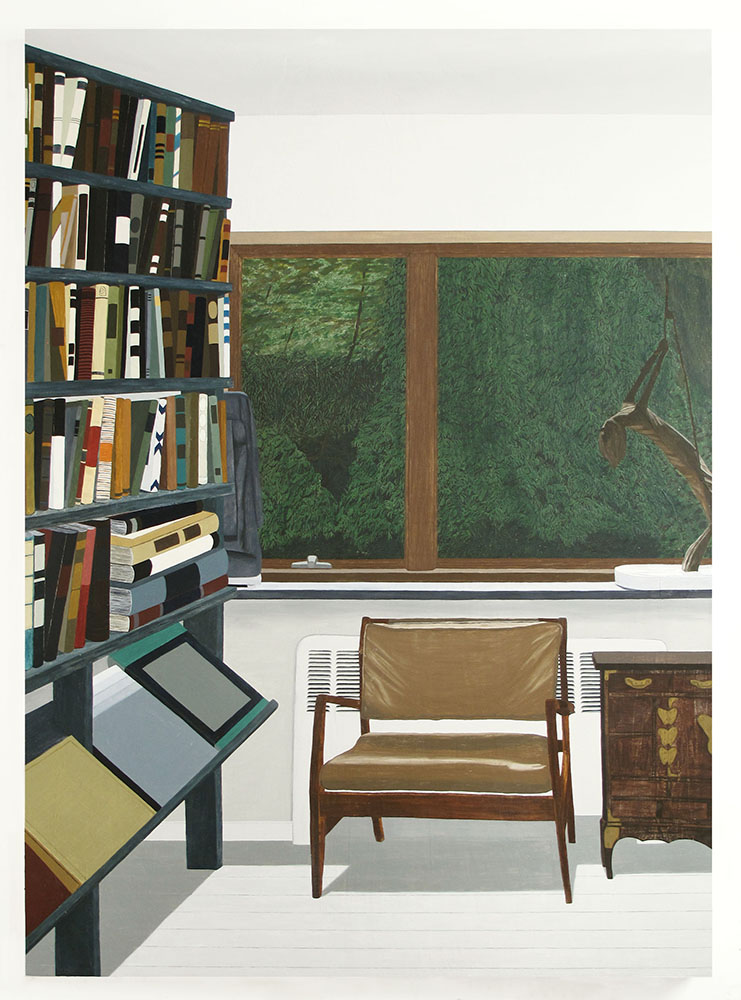
Reading Room
You mentioned that those paintings look different from your more recent works. How did you arrive at the distinctive, more representational style you have now?
When I was in California, I had this approach that was like, all right — you’re just going to do an instinctive take on what it looks like to you. You’re not going to try to push it. You’re not going to try to abstract it. You’re not going to try to make it look more realistic. It was less about making decisions — I didn’t deliberately say, “Okay, well, these are interiors, so I’m going to make these really clean, crisp edges.” I sort of did it and then noticed I was doing it, and thought, “Okay, what has to happen here?” The painting has to be painted on a surface that’s perfectly prepared, and the paint has to be much thinner, because you have this relationship between the depicted wall and the actual wall next to it when the painting’s hanging in a gallery. When I was making paintings of landscapes, they were essentially windows. I didn’t have to contend with those spatial relationships.
Growing up, learning to make paintings in the ‘90s and early 2000s, it was always like, “Don’t look at a photograph. Don’t use tape. Don’t use a projection.” Everything was supposed be this 20th-century Modernist, Abstract Expressionist idea about painting, and if you did anything else, it was bad. I basically had to throw out all of those lessons, because for me, it did make sense to use a laser level and tape for everything. It didn’t make the painting worse. It was a different kind of painting, and it made it better.
Speaking of artists from the past, do you find yourself inspired by artists who may have also worked within the realm of domestic interiors?
Yes. I feel like I was very much raised in the 20th century, so my influences back then were, like, all men. David Hockney, and all of those artists at the Barnes, like Rousseau and Matisse. But if I try to contextualize myself with them it’s like… I don’t know if you know Nicki Maloof’s paintings? Or Ann Toebbe, Aliza Nisenbaum — a lot of these women are my age, and I see myself much more in line with what they’re doing than the painters I grew up being influenced by.
It’s similar with literature. If I think about what I was thinking about when I first started making paintings, it was like Carver, Cheever, Updike. I mean, I still have a special place for those books in the way they describe America, but it’s an America that is so male-centric. When you reread them, you’re like, “Oh my God. John Updike, what an awful person.” It’s painful to read his female characters.
But I’m less and less interested in that; a lot of the reading that I do has been children’s literature for the past few years, so I feel much more influenced by that than the literature I was reading a long time ago.
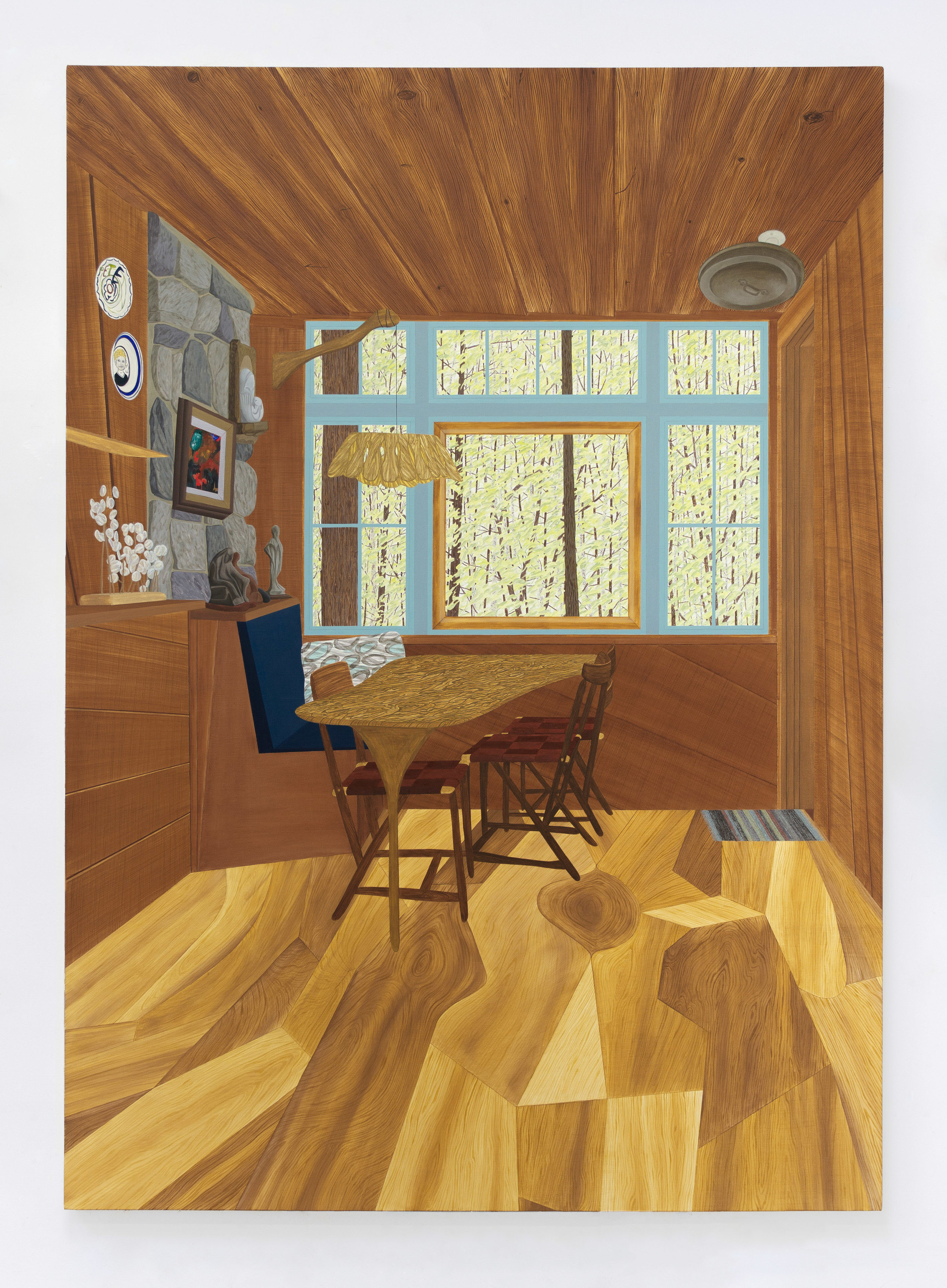
Dining Room (Wharton Esherick), 2018
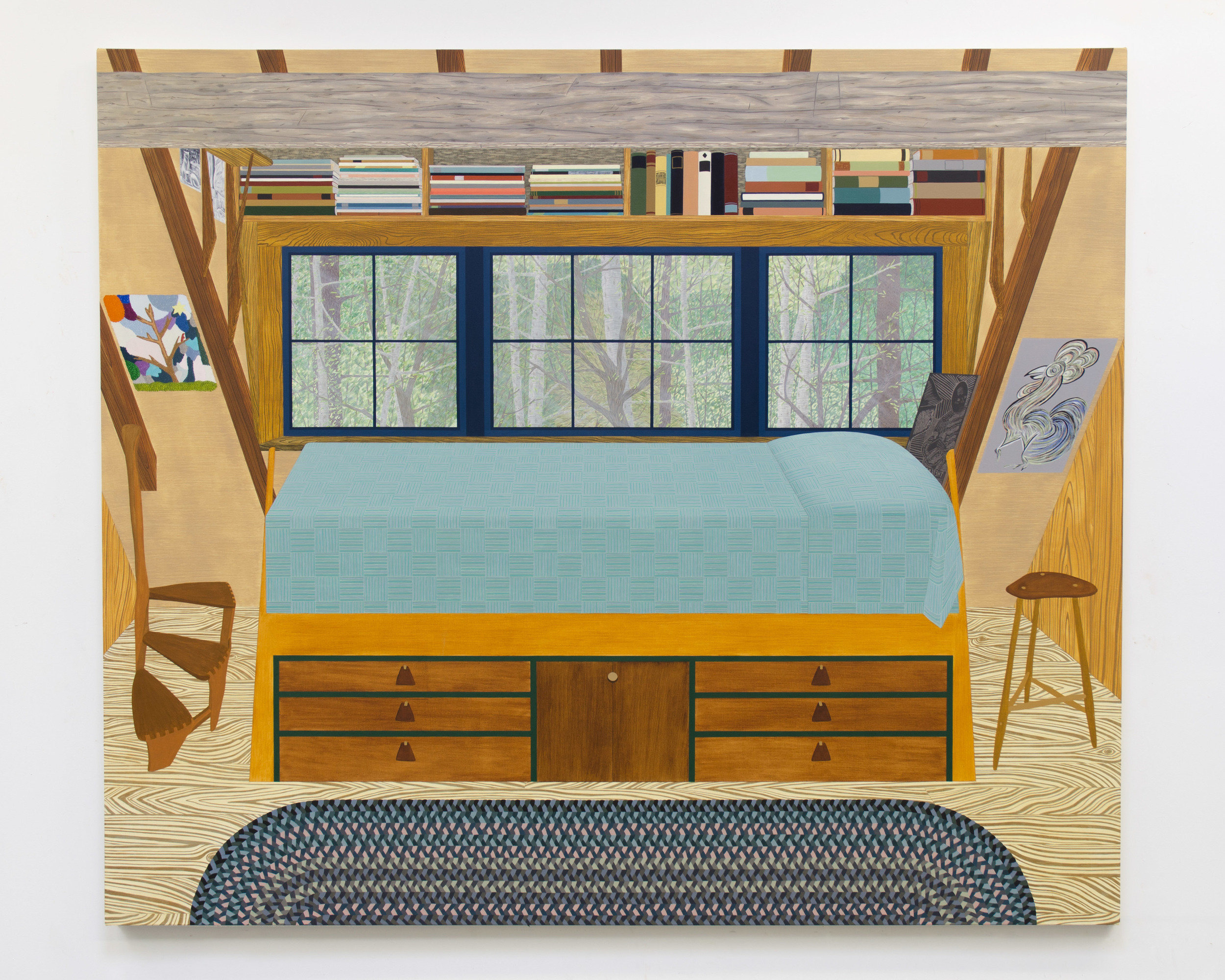
Wharton Esherick Bedroom, 2018
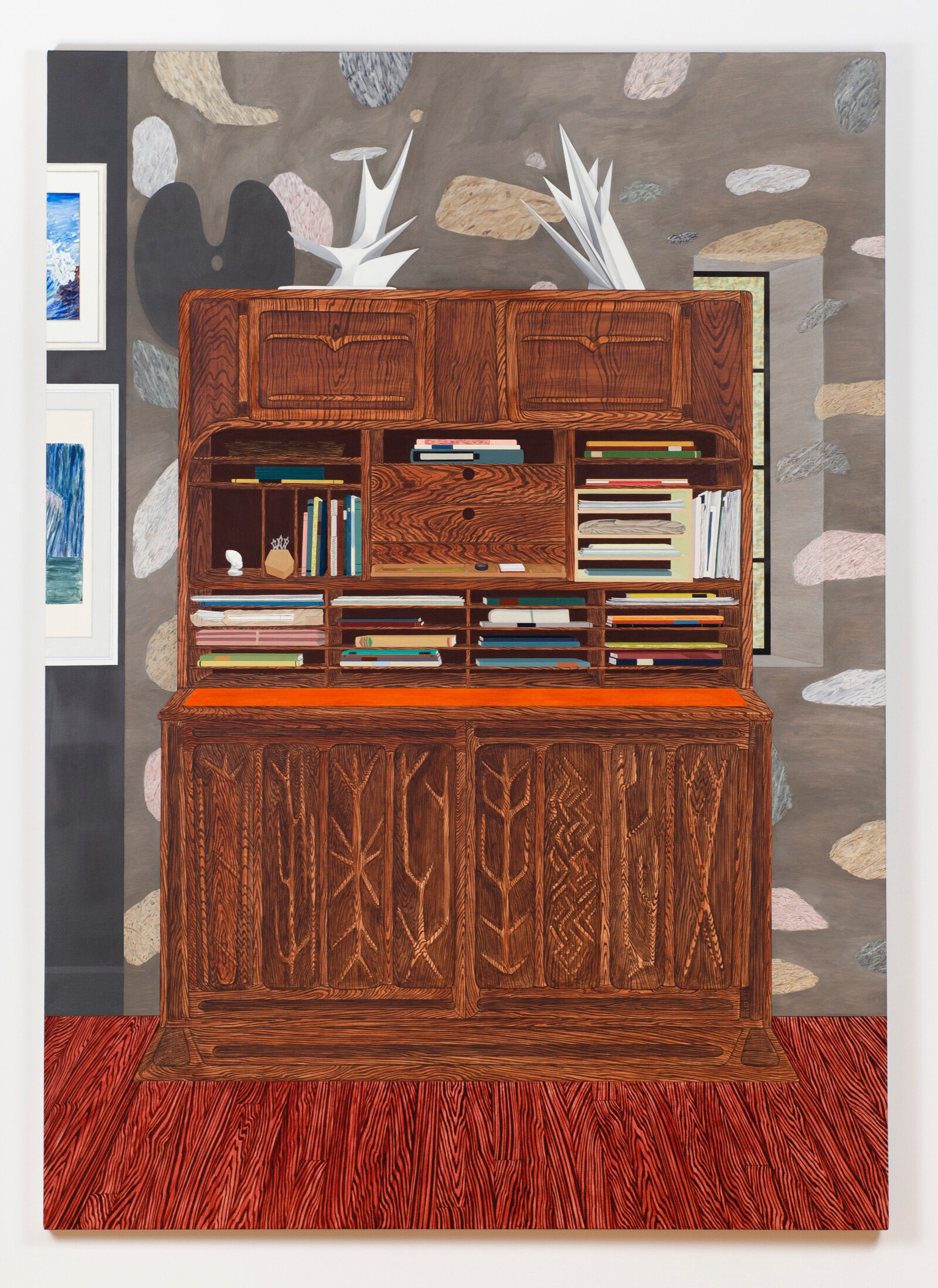
Drop Leaf Desk (Wharton Esherick), 2019
Tell me about that deep dive into children’s literature. I know you had one series based on fictional chapter-book interiors, like the black marble bathroom in From the Mixed-Up Files of Mrs. Basil E. Frankweiler. How have your subjects evolved?
So, those original paintings are of my grandparents’ house, and that body of work was very true to the subject matter. I had tons of childhood photos and I had still-lifes, because I had the objects right in front of me. The next body of work was a little less specific. I would start with a couple of objects that were meaningful to me – like a lamp that belonged to my mother’s mother — and I went on to imagine what the house she grew up in would have been like, based on the era of the house, my mom, and her taste. It was my invented version of it.
I moved more and more into being able to invent spaces that still resonated with things that I remembered, and the process of making them was still very similar. It was piecing together bits of things that I recalled, and then Googling things and being like, oh, I want to put that rug in. That’s a $300,000 rug. I’ll never have that rug, but I can take it off the Internet and put it in this painting.
When I was pregnant with my son, though, I was like, I can’t make all this personal work. It’s too draining. Around that time, I was visiting the Wharton Esherick Museum right outside of Philadelphia. Every time I go into a house, I’m always with my phone, like, “Oh, I want to steal that detail. I want to steal that.” In Esherick’s house, it was even more. I was thinking about this idea of domestic space within the space of the gallery, but also art objects in the space of the domestic, and I was like — this is all Esherick does. There’s no distinction between the art space and the domestic space. I was like, I should just make a whole show about this, then I don’t have to worry about each painting dredging up something autobiographical. Of course, in the end, it was just as hard, but it was great because I realized that the process was relevant, even if I wasn’t doing directly autobiographical paintings.
So, after that — again, I have this little kid. I’m thinking about being a woman and making paintings in the wake of 2016. I had a show at Jack Shainman called Homemaker, where I was thinking a lot about the legacy of homemaking. I used to say, “My grandfather fought in the war and my other grandfather was a medic, and then, you know, one came back and he was a cardiologist, and the other came back and he had a factory in Greenpoint.” This was the family legacy. But the other family legacy that nobody ever talks about is that there were generations of women who organized and kept their homes, and everything was absolutely dependent upon them.
2016 certainly brought that into a sharp focus for a lot of us; the election laid bare the way that this country doesn’t value women. I was thinking about being a mom, and being a working mom, and how children occupy the domestic space, as well. Without these children, we do not have a generation to take care of us when we get old. We don’t have future scientists, or doctors, or nurses. People think women should work, but we don’t want to give them a good option for high-quality daycare.
I was also just thinking about being at the studio a lot and I couldn’t stop thinking about my kid. So, one of my solutions was to create this body of work about children’s books. I was like, “I’m going to organize a library for my son, and it’s going to manifest in these paintings.”
I kept thinking about this book I read with my dad when I was 10 or 11. It was Salman Rushdie’s first children’s novel. He only wrote two, one for each of his sons, and this one was called Haroun and the Sea of Stories. It had this really great scene in a houseboat with two rooms next to each other. One side had a bed that was shaped like a turtle, and the other side had a bed that was shaped like a peacock. I kept thinking, “Man, that would make a great painting.” I didn’t know exactly how to frame it, but I was thinking about the way that my work focuses on memory. It was perfect, because with these chapter books, I have memories of what stuck with me when I read them when I was a kid — memories which may or may not be accurate. And then, as an adult, I can reread them and understand the historical context. And then the third layer is history, which is so rich because I can research it. What year was this book written? When was this supposed to have taken place? What did houseboats in Kashmir look like in the 1960s, 70s, or 80s?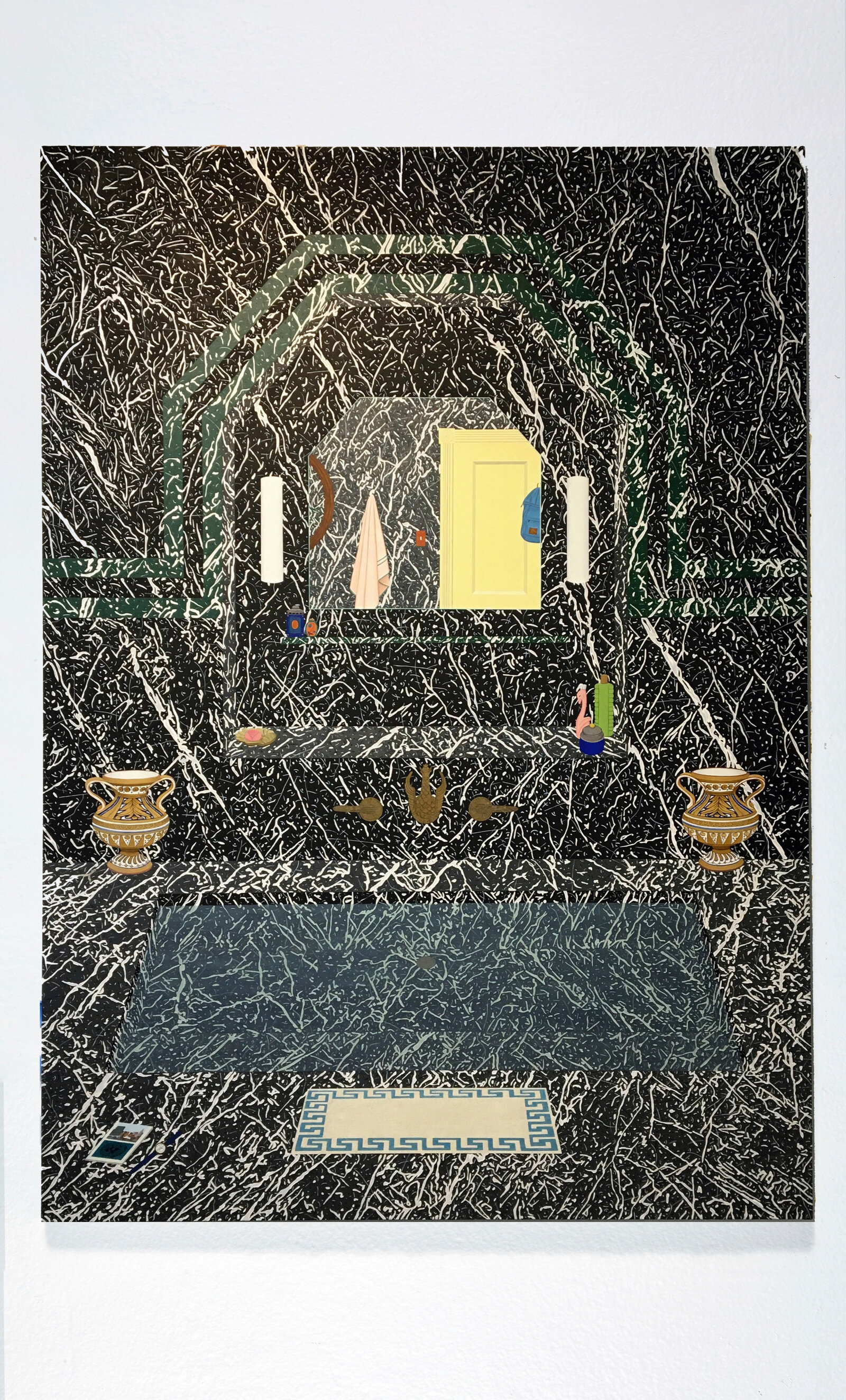
To Be Titled, 2019
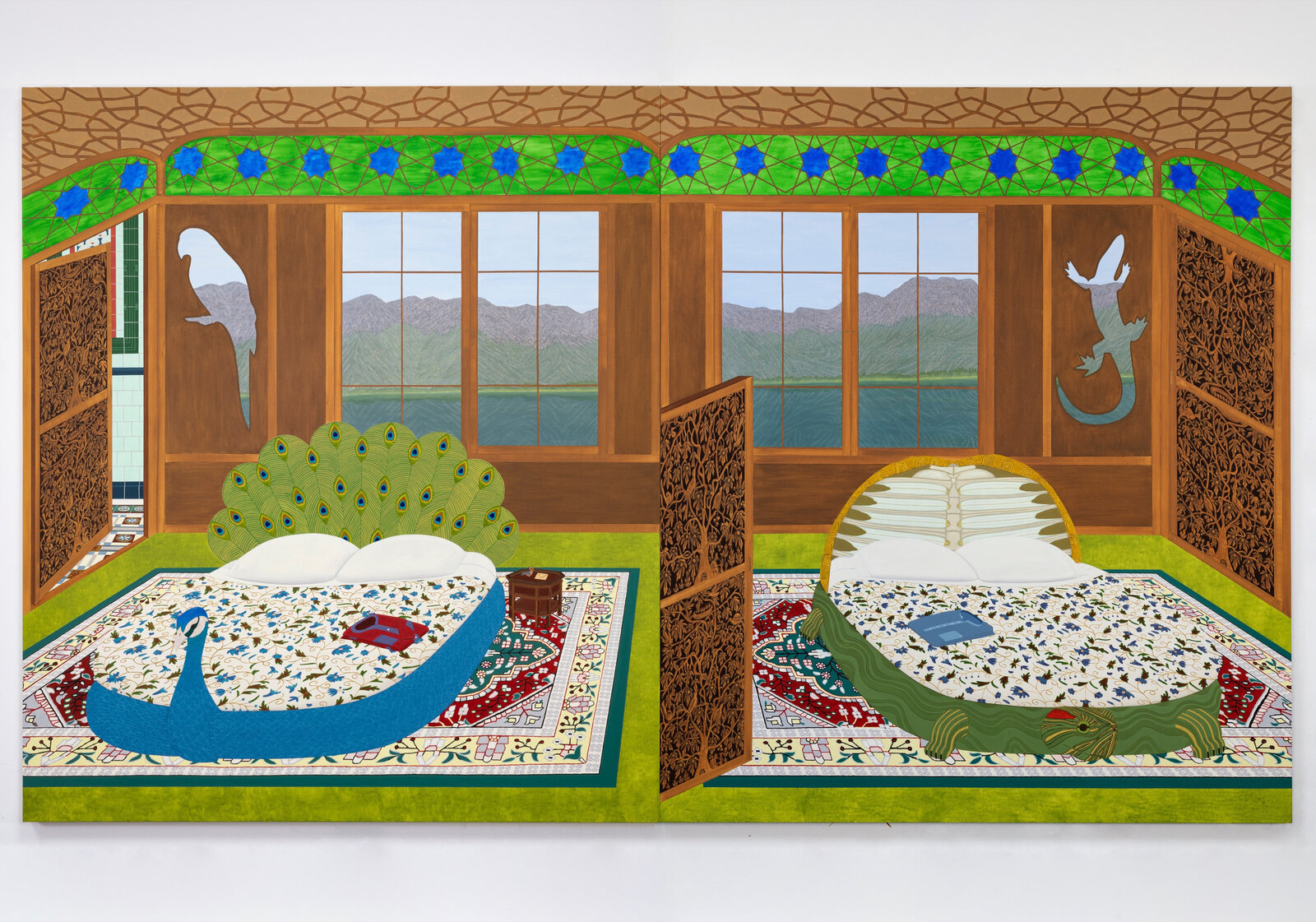
Houseboat on Dull Lake in the Valley of K, 2020
You’ve mentioned Google image searches a few times. Can you talk a little bit about your research process?
Yeah, I usually have my own personal photos and I’ll have all of this stuff that I’ve looked up or read about. I made a painting that’s at the show in Kinderhook from the book Roll of Thunder, Hear My Cry, set in 1930s Mississippi. To research it, I went to the Library of Congress, which has all of these archived photographed from that era. I spent hours going through and finding the relevant ones, and dragging them to my desktop. So, it’s a combination of structuring the space and then adding these elements that I’ve researched and compiled, along with actual objects, too.
I want to talk about the show in Kinderhook but first let’s talk about how your collaboration with the harpist Mary Lattimore came to be. That’s actually how I found your work! I had posted an album cover that I love of hers on Instagram and someone wrote back saying, “That’s Becky Suss, she’s the coolest.”
That’s awesome. Mary’s an old friend. She was probably one of my husband’s first friends when he moved to Philadelphia. She played the harp at our wedding. Mary came to me, because she’s always loved my paintings, and she was like, “Hey, would you think about making an album cover for me?” I’m not really good illustrating something, but I was like, “What if we pick a painting?” And she was like, “Oh, that’s even better.” And you know, there’s an overlapping sentiment in our work. My paintings are very devoid of people; Mary doesn’t have vocals in her music. Her albums are really atmospheric. They have a sense of place. And I don’t know whether or not it’s relevant, but Mary loves her stuff. She has all these nice beautiful little things around her house in LA.
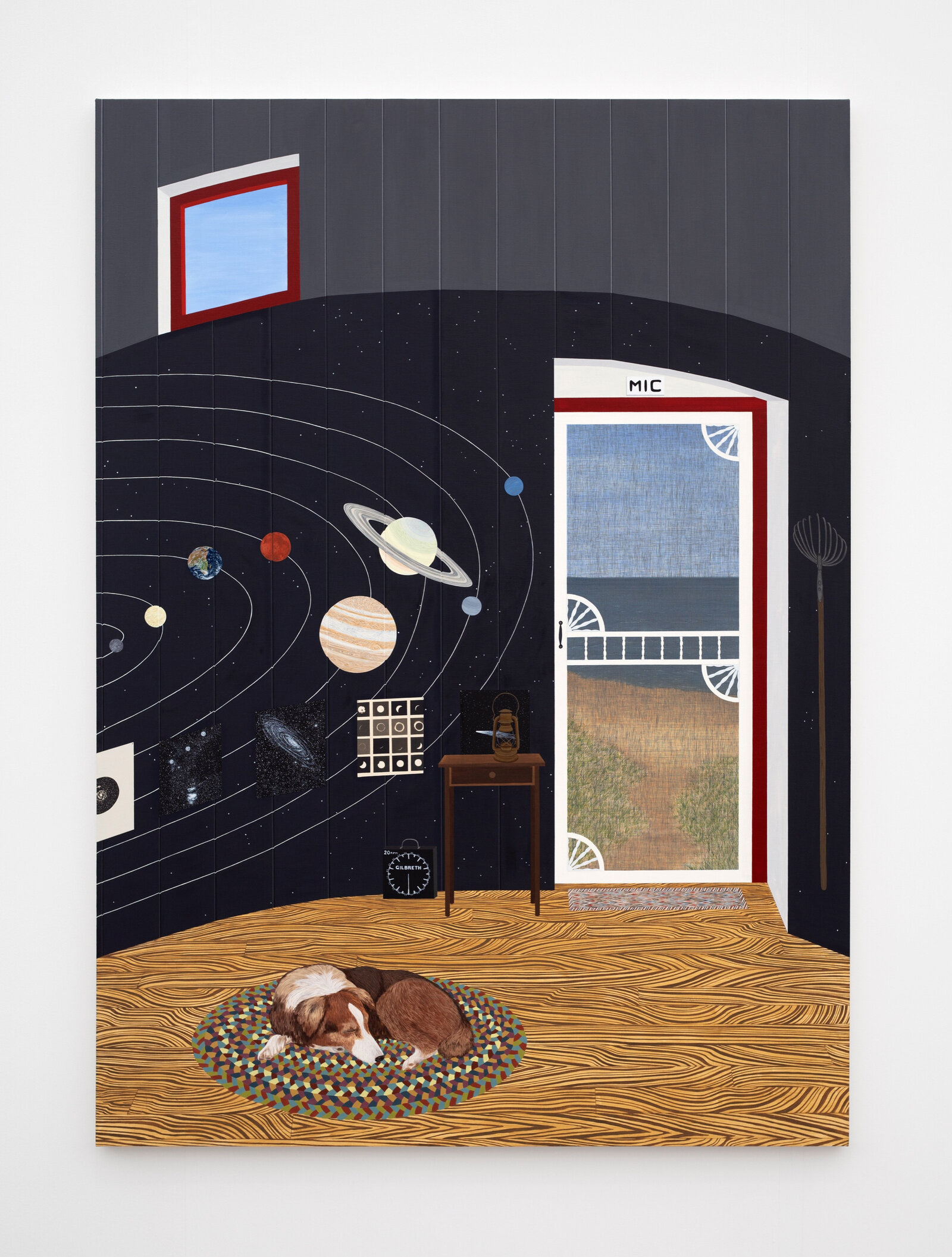
Mic (Lighthouse with Solar System), 2019

August, 2016
Ok, so now tell me about the paintings you’re showing for Feedback, the exhibition curated by Helen Molesworth at The School in Kinderhook.
So, at the show right now, there’s actually that very first painting that I mentioned of the corner of my grandparents’ house. It’s the only big painting of mine that I held on to, and they borrowed it. The whole theme of the show has to do with feedback and education, and how we learn, what we learn, and what institutions we learn in.
Another painting in the show is Behind the A to Z, and that was in a previous show at Jack Shainman about children’s books. It’s from the book The Egypt Game by Zilpha Keatley Snyder, which is a book I read in fourth grade. The Egypt Game takes place in California, in a college town, and it’s about these kids who play a game behind the A to Z, which is a junk shop run by a Middle Eastern man they call the professor. There’s a little white girl whose mother abandoned her because she wants to be an actress in Southern California. And then there’s this family with a little girl and a little boy who are African-American, and their parents are in graduate school getting their PhDs. The story was written in the 1960s, so it’s a racial picture that you didn’t often see, I don’t think, at that time. The kids are all friends and they play this game about Egypt together, but in reality, there are these crimes playing out around them, and they’re being blamed on the Middle Eastern man who owns the A to Z. It’s not a domestic space, but it is a space that these kids built. I felt like it was a really interesting departure.
The other painting in the show that’s never been shown before is from Roll of Thunder, Hear My Cry, which I mentioned, which is about an African-American girl in southern Mississippi in the 1930s, and it paints a really complicated picture of what life was like there, especially for an African-American family. It delves into the history of Reconstruction and this family’s legacy, where they own this land, but since post-reconstruction the white people in the community have been trying to take it back. The mother’s a teacher and is teaching her Black students about Reconstruction and the schools are saying, “That’s not part of the curriculum, you can’t teach them that,” and she gets fired.
You know, part of this is thinking what I want to memorialize for my son. Like I reread The Adventures of Tom Sawyer, and I was like, oh, no. No. No. No. That is not something we’re going to elevate right now. Maybe when he’s older and we can have a conversation about race and slavery, but that’s not the sort of book I want to represent. I’m thinking about what it means to be a mom of this little white, blond-haired, blue-eyed kid, too.
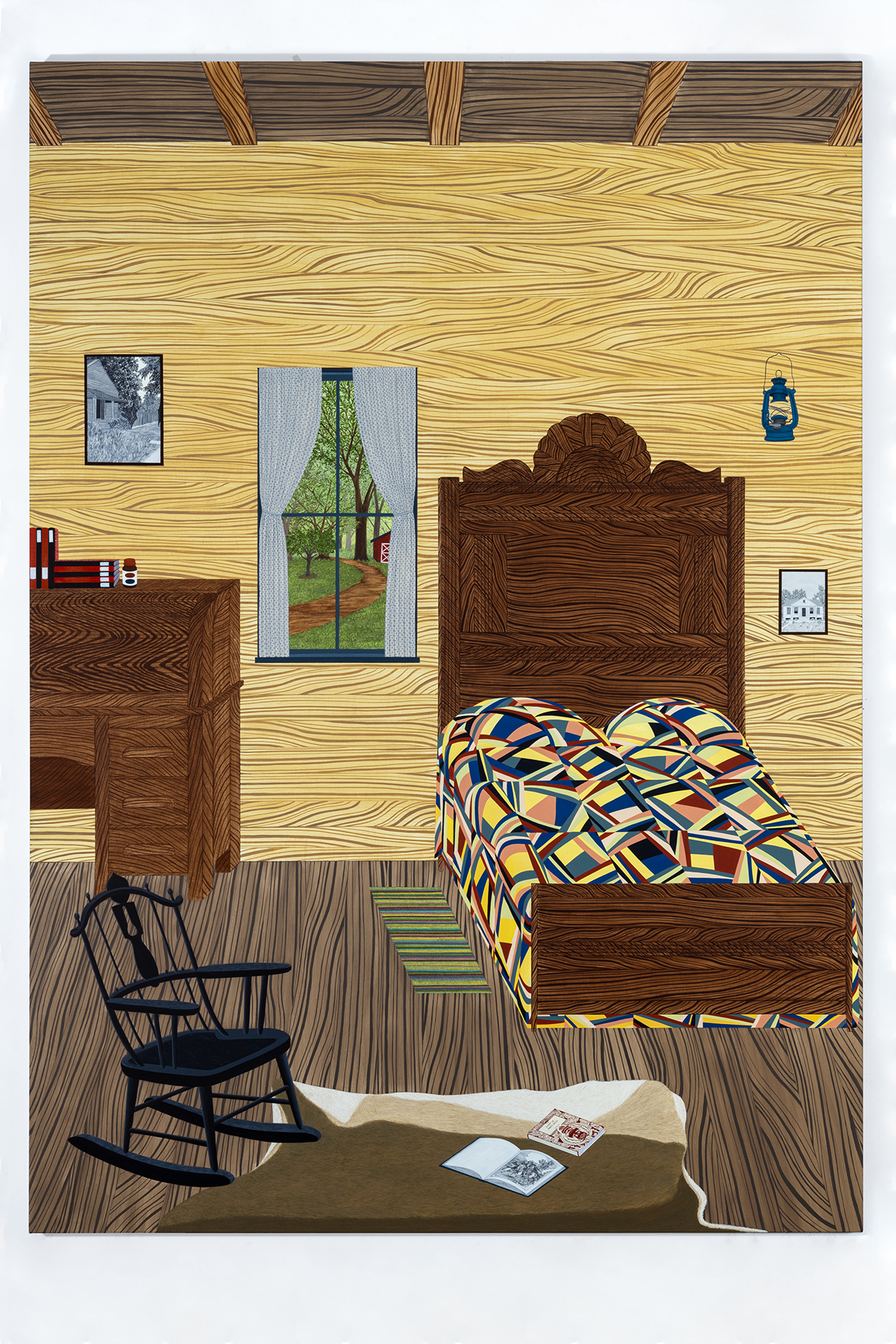
Logan Family Home (1933), 2020
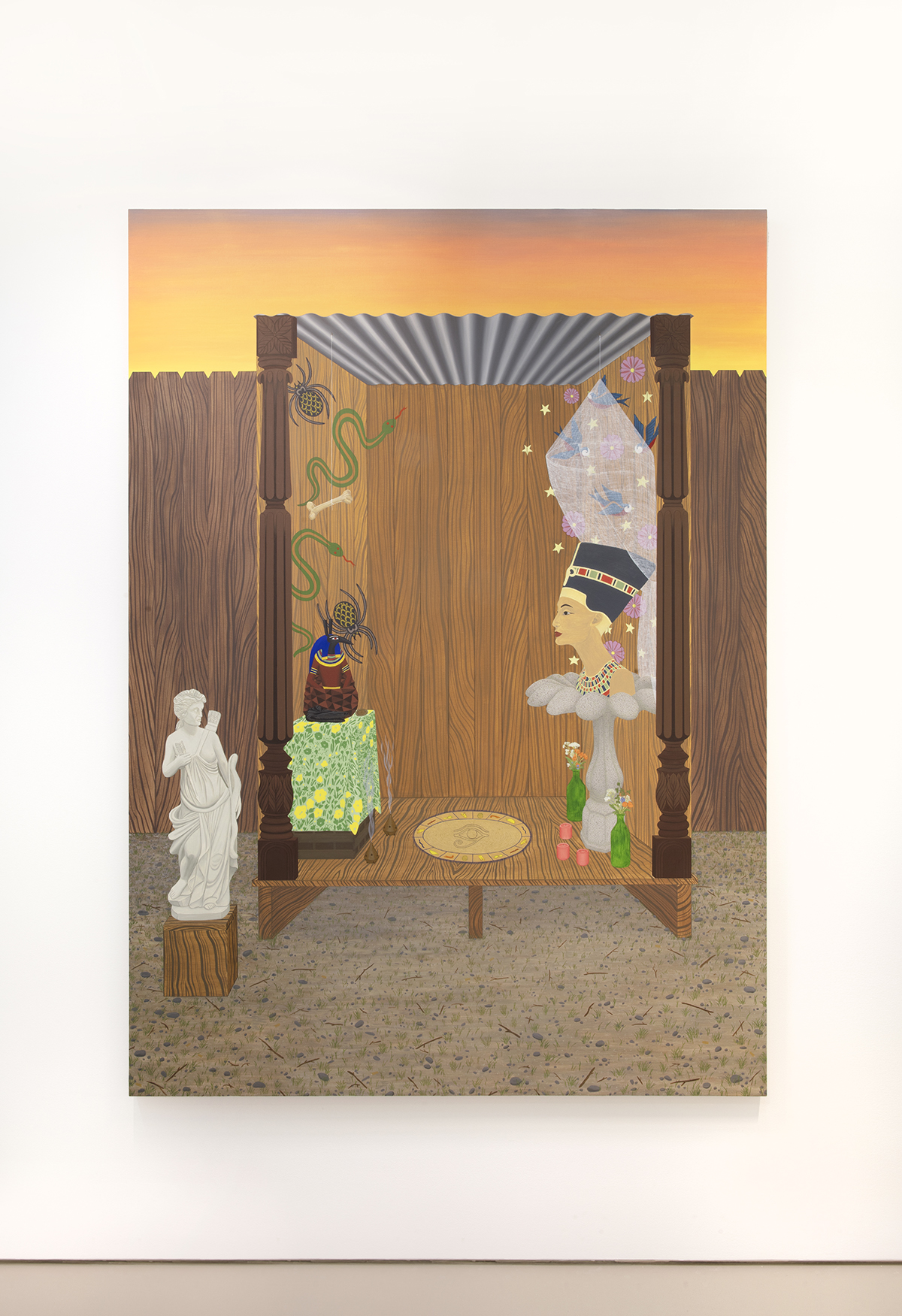
Behind the A-Z, 2019
Now that your son is a bit older, do you feel like you’ll delve back into subjects that are a bit more personal again?
Yes, I have a painting in a group show at the Philadelphia Art Museum right now, and it’s a painting of the house I grew up in. I never did that before, because I felt like it was too close, but then because of COVID, we lost our childcare. My parents started watching my son, and we all quarantined at my parents’ house in the suburbs. I just brought the painting there, and I made it in their living room. It was interesting to watch my son’s life at 2 years old play out in front of the same backdrop that mine did, and I decided that now was the time to make a painting of that room.
So right now I’m working on a series of paintings for a show at Jack Shainman next year, and they’re all going to be paintings of that same room. Different iterations of time, different stages. I’m interested in having clues that take you from one painting to another. Like in one painting, the whole wall is papered with the wallpaper that was original to the room when I was really young. The next painting has the wallpaper I remember from most of my childhood, but inside of the closet, behind the books, is that original wallpaper. So, there are things like that that can offer clues that this is the same space, moving through time.
Your work obviously deals so much with the past. How often do contemporary ideas or trends make it into your work?
The only sort of deliberate, specific thing that I do is that I have a subscription to The World of Interiors. They’ll have an 18th century farmhouse that’s never been renovated, and then they’ll have these beautiful brand-new things. It’s such a mix. But other than that, like I said before, if I’m at somebody’s house or at a store, I’ll take a picture of something and be like, “Oh yeah, that’s a good one.”
Besides your childhood home, is there an interior that you’ve always wanted to paint, but haven’t been able to?
There’s one painting that always comes back to me. I want to make a huge painting of the original Metropolitan Opera House. It isn’t a domestic interior, but it was on my mind years ago, when I was working toward that show Homemaker, and I was thinking about the legacy of domesticity and homemaking. Most of these women, after the turn of the century, had aspirations and simply didn’t get to achieve them. My grandmother, who I never met, studied opera and wanted to be an opera singer, but the war broke out. At that point, you had to study opera in Europe, and instead, she met my grandfather and married, and they had three kids, and she was the doctor’s wife. I’ve been thinking about that alternative legacy. She went to the opera every week, and she died in the early ’70s, probably right around when they built the new Metropolitan Opera. So, I was thinking it would be such a great monument and gesture to the possibility of a career that she could have had.
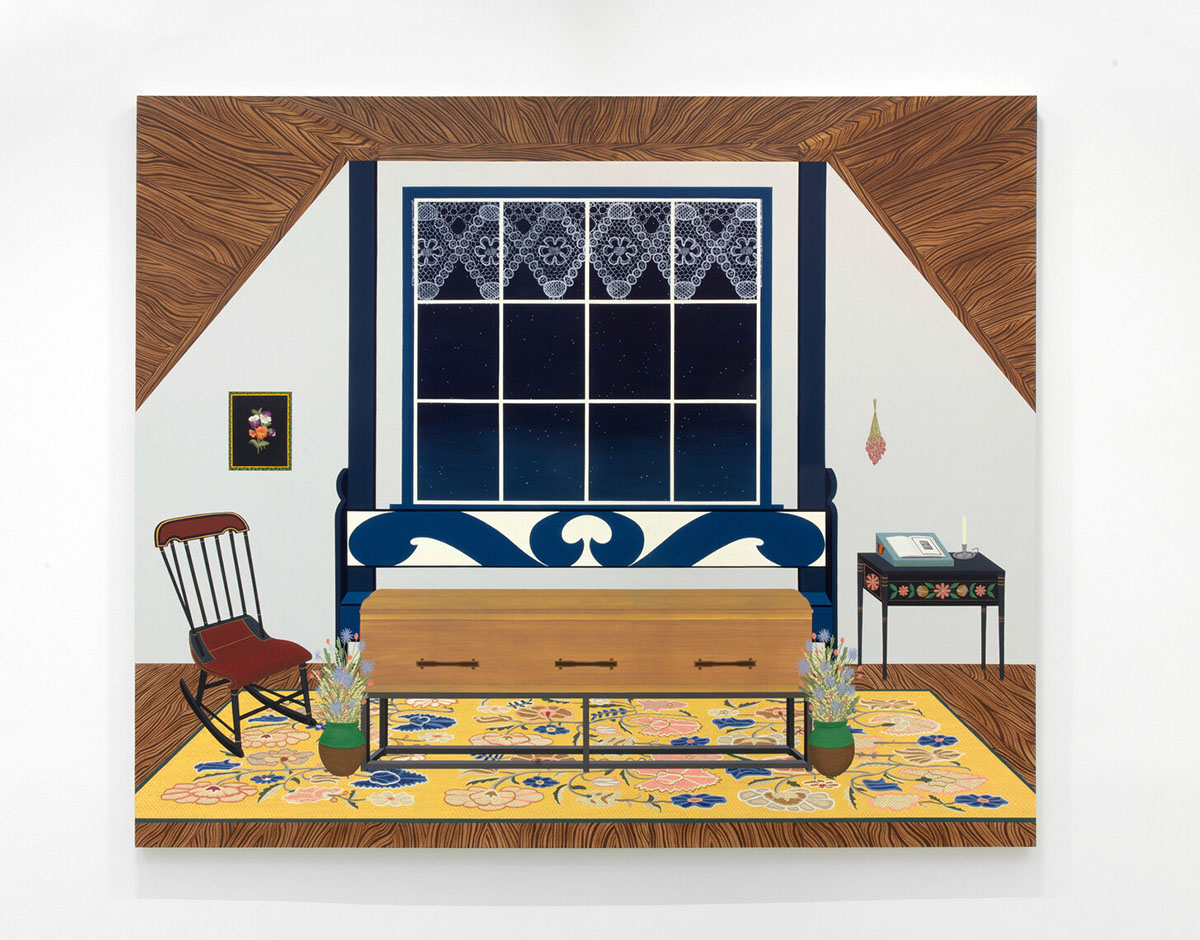
Henrik’s House (Great Aunt Birte’s Funeral), 2020
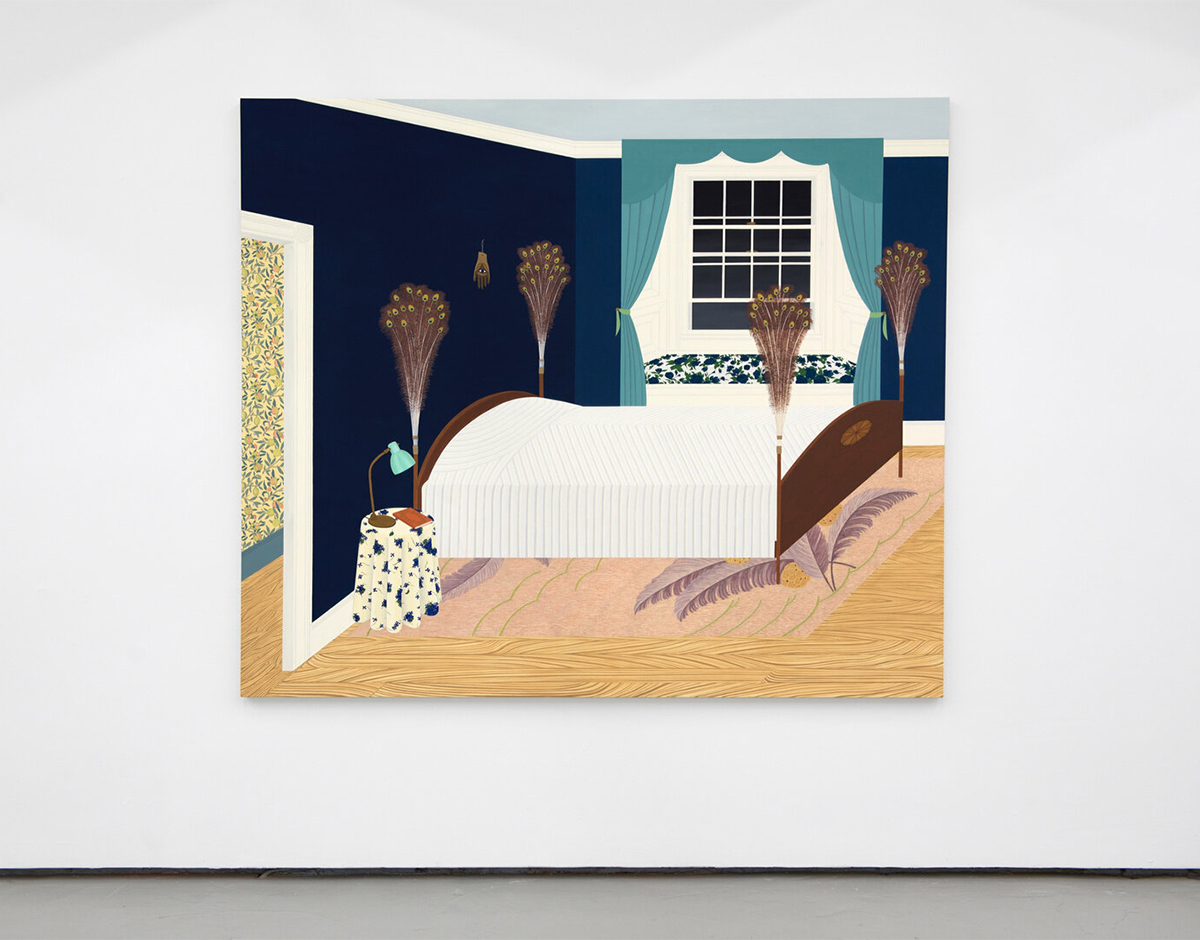
Bedroom with Peacock Feathers, 2017
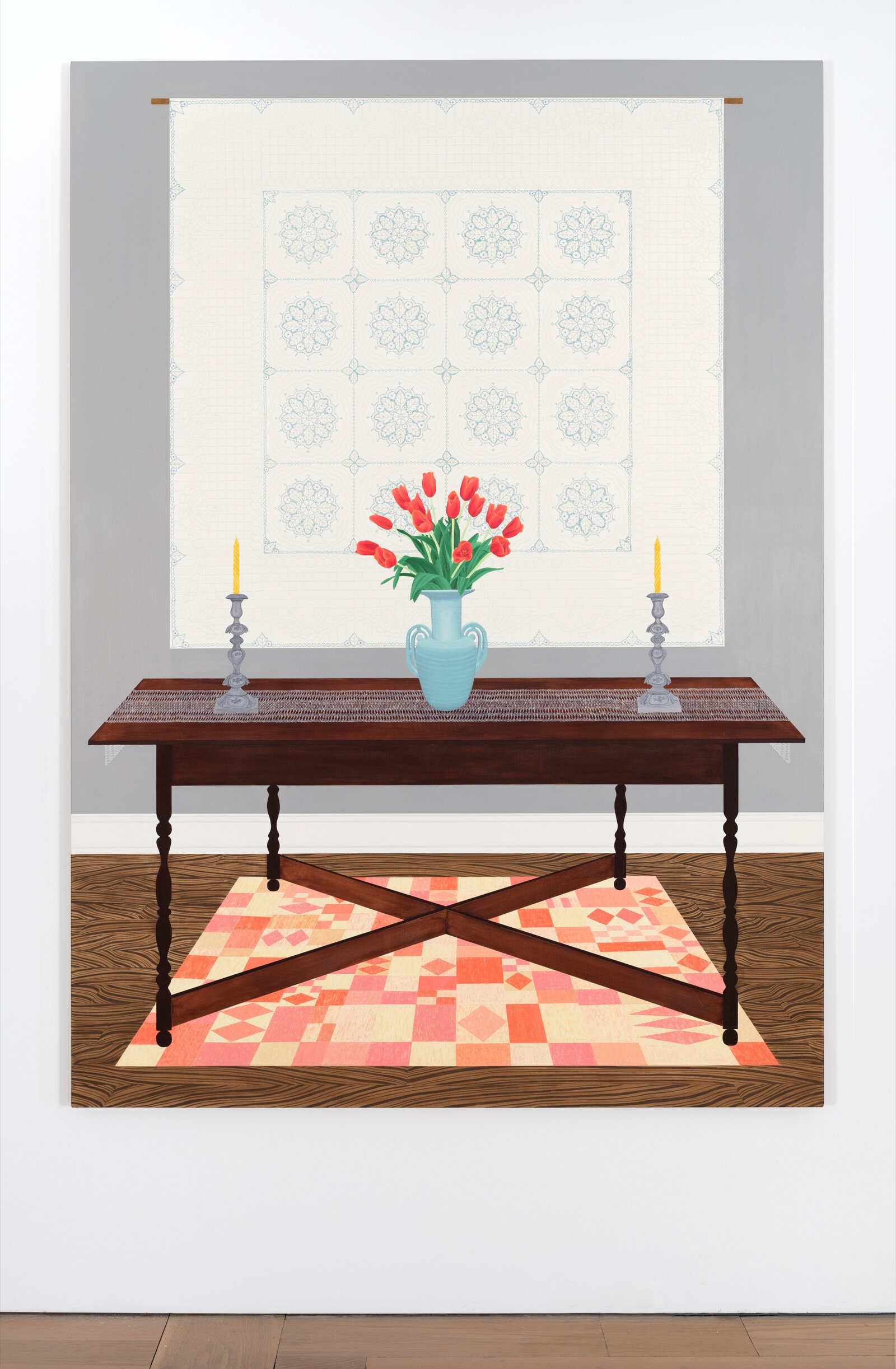
Foyer (Helen’s Quilt), 2017
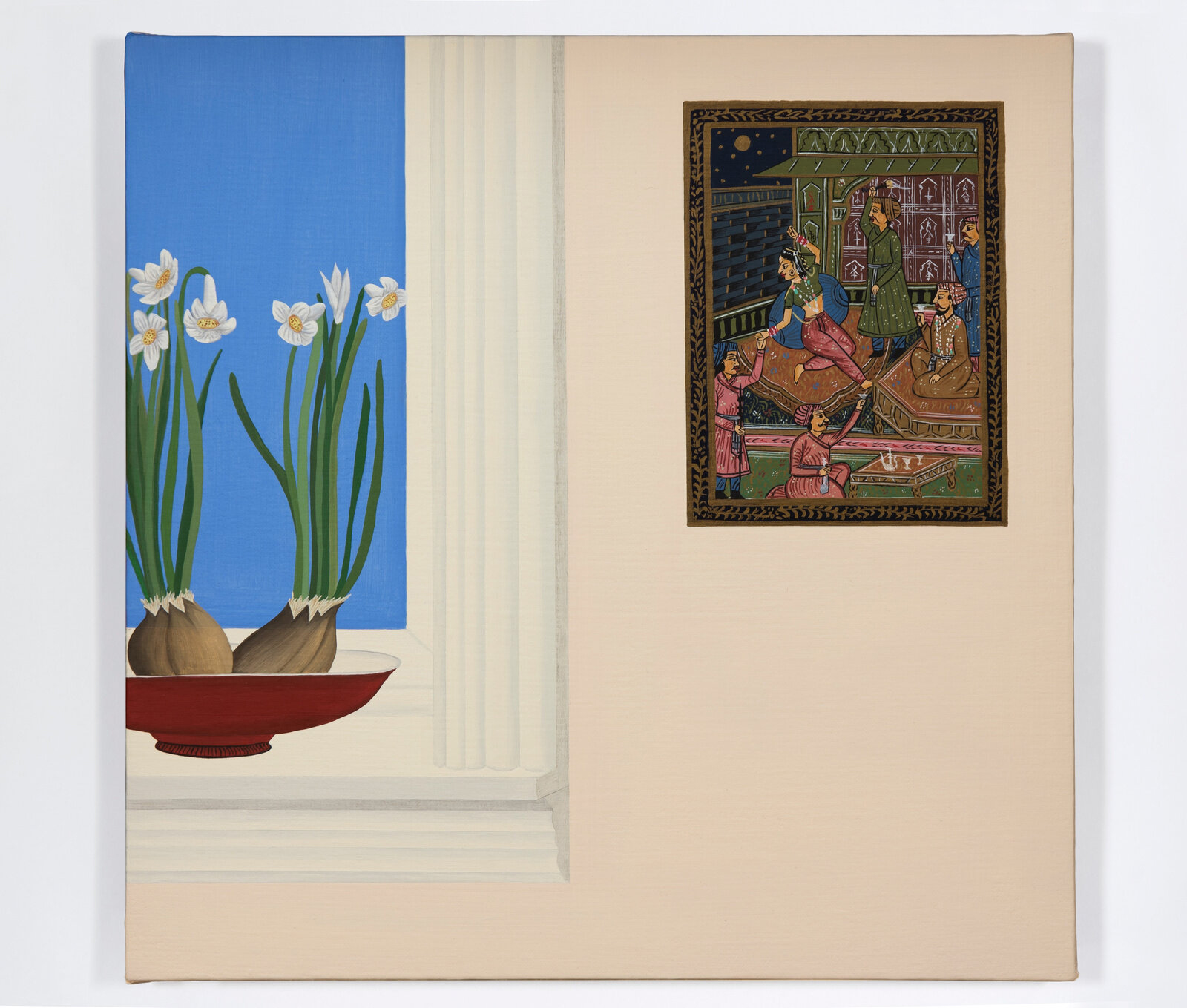
In Memoriam (for Emily), 2017
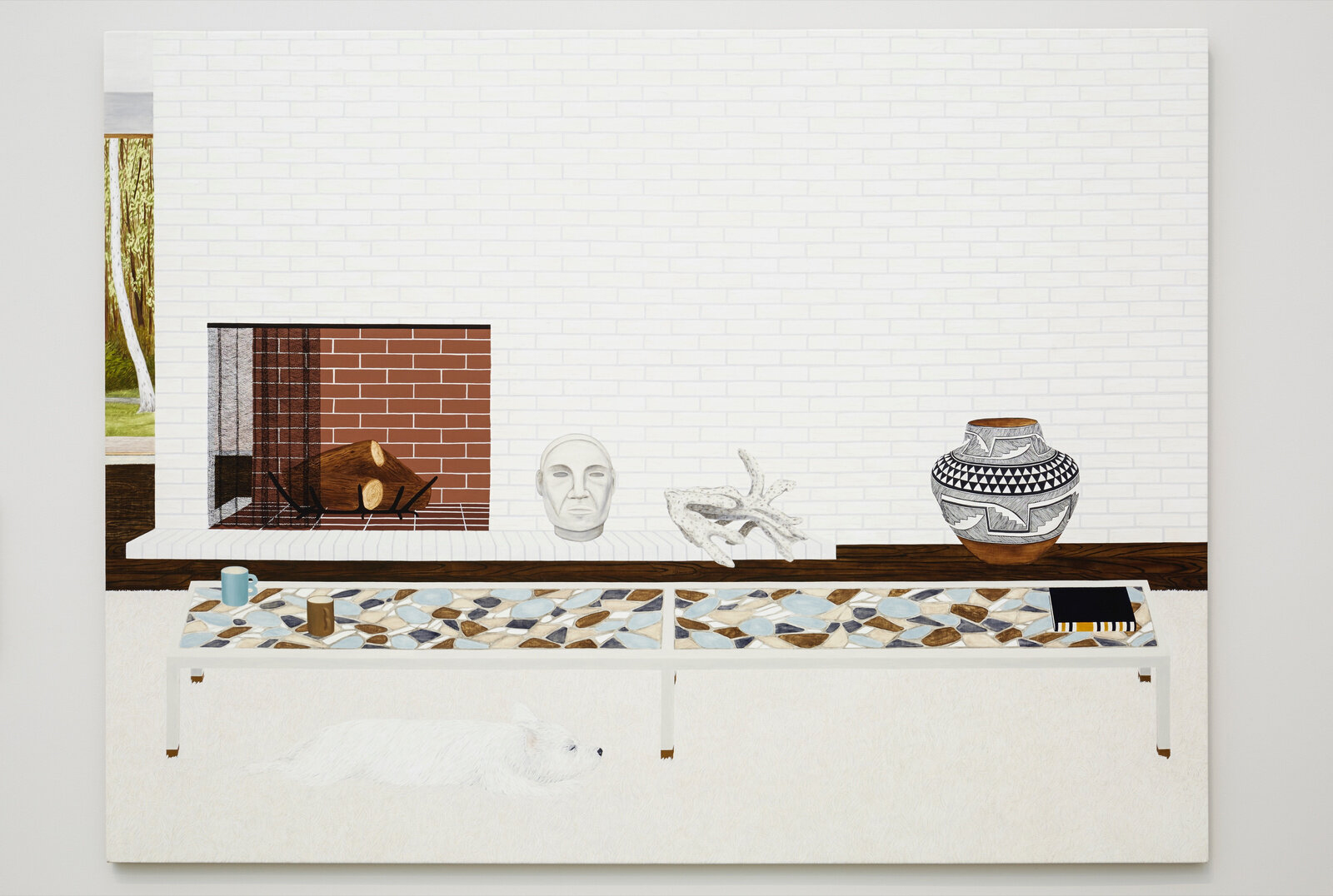
Living Room (Yogi 2), 2013
